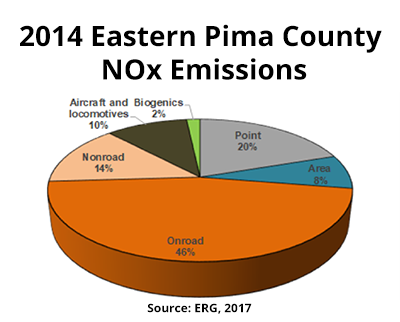As the region’s air quality planning organization, Pima Association of Governments recognizes the benefits of passenger and commercial vehicles using alternative transportation fuels to improve the air quality in our region. Electric vehicles, in particular, emit zero tailpipe emissions to the local airshed where they are operated.

Cleaner alternatives to gasoline and diesel include electricity, compressed natural gas (CNG), liquid natural gas (LNG), propane and hydrogen. They emit fewer common air pollutants regulated under the U.S. Environmental Protection Agency’s National Ambient Air Quality Standards (NAAQS); fewer mobile source toxic hazardous air pollutants (HAPs), and fewer greenhouse gases.
Air pollutant emissions from onroad and nonroad transportation fuels make up 60% of regional nitrogen oxide (NOx) emissions. NOx and volatile organic compounds are precursor air pollutants that combine to produce ground-level ozone, a harmful lung irritant.
Ozone is a NAAQS pollutant of regional concern, as air quality monitoring data from the Pima County Department of Environmental Quality indicated a design value level of 0.070 parts per million (ppm) for 2022, right at the NAAQS standard of 0.070 ppm. Reducing regional transportation-related NOx emissions through the transition to cleaner fuels can help maintain attainment with the federal ozone standard and avoid increased and costly regulatory requirements.
PAG partners with other regional agencies to explore best practices and opportunities for air pollutant reductions through the increased use of alternative fuels.

In addition, PAG conducts regional greenhouse gas emission inventories biennially and adopted the 2015 Resolution for Regional Resilience to Climate and Weather Variability. Another benefit of using cleaner fuels is the corresponding reduction in greenhouse gas emissions, particularly carbon dioxide (CO2). PAG’s most recent 2021 Greenhouse Gas Inventory Report indicates that 43% of regional greenhouse gas emissions come from the transportation sector. The City of Tucson has developed a 10-year Climate Action and Adaptation Plan.
Alternative Fuels Corridor Deployment Plan
In November 2020, PAG released the Arizona I-10 Alternative Fuels Corridor Deployment Plan for electric vehicle charging and compressed natural gas (CNG) fueling, funded by a planning grant through the Federal Highway Administration (FHWA). This plan will benefit the region by increasing the available infrastructure for CNG and electric vehicles to support the use of cleaner fuels and help improve air quality.

